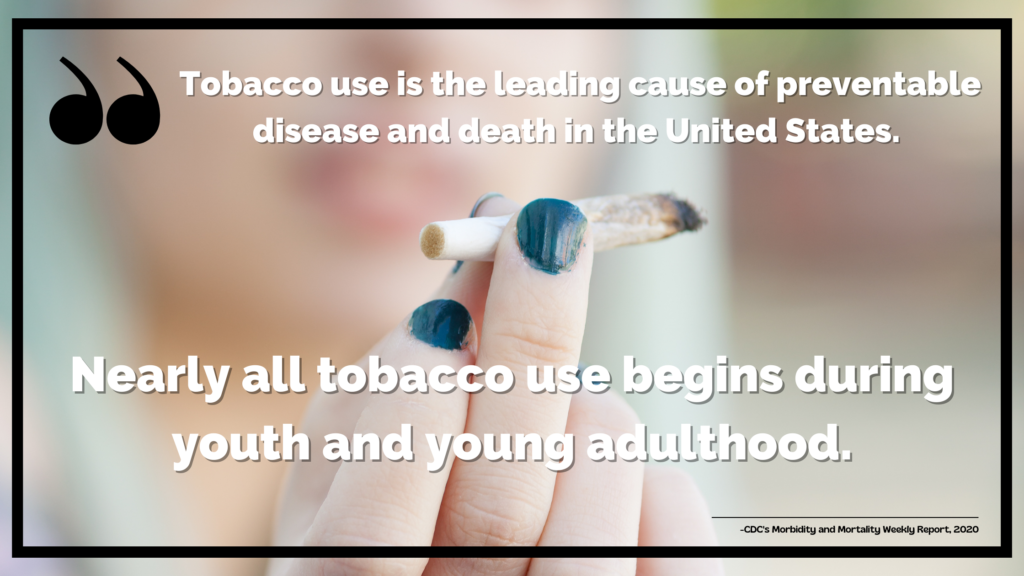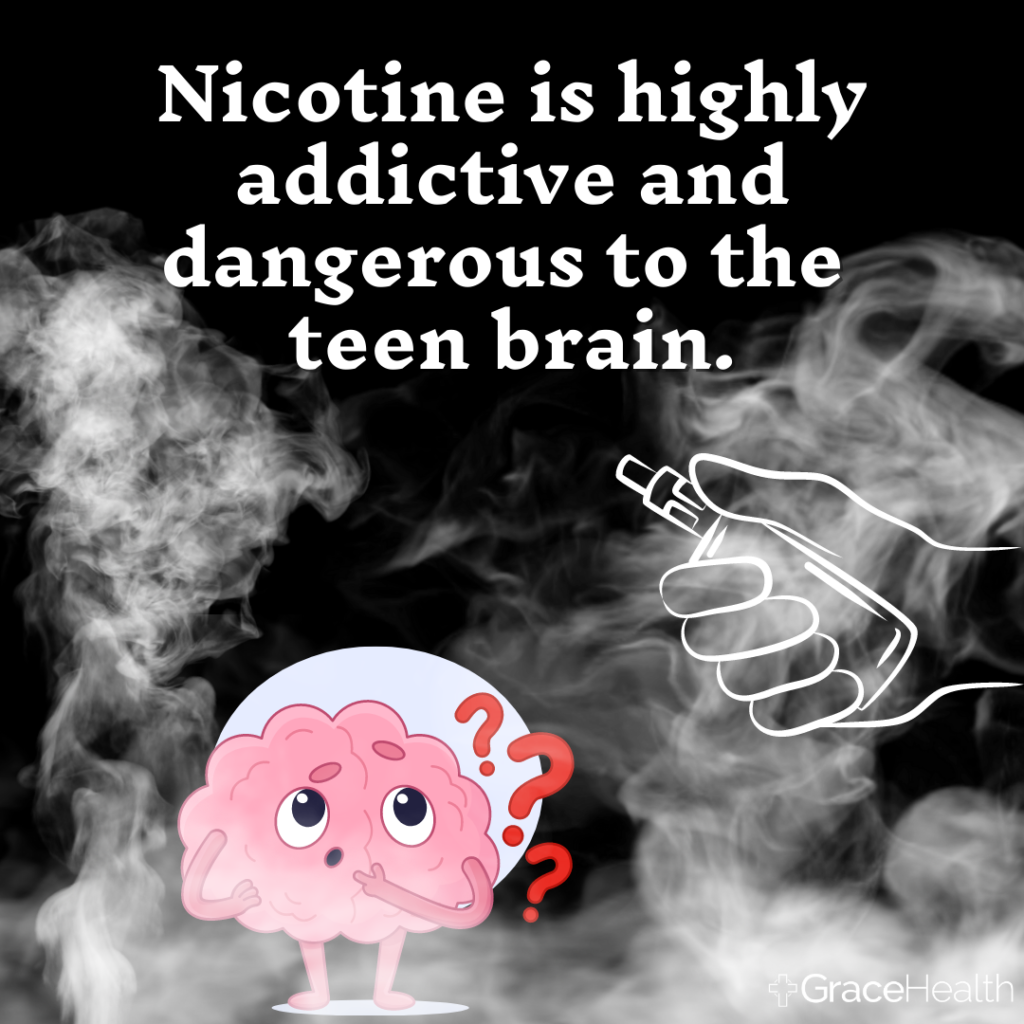By: Alaza (Allie) Lowe, BHuServ, BSc Psychology
Behavioral Health Care Coordinator at Grace Health Falls Highway Clinic and Grace Health Pediatrics Clinic
What is vaping?
Vaping is inhaling a vapor created by an electronic cigarette, or an e-cigarette. In our everyday lives, we see multitudes of people “puffing” on these devices and stores dedicated to selling the liquid nicotine, commonly known as “vape juice”, that goes into them.
With an abundance of delicious-sounding flavors available, like strawberry, cinnamon, vanilla, and chocolate, it is no wonder children and teenagers are drawn to them. Also available are CBD-infused products that can be used to fill reusable vapes (AKA “mods” or “tanks”).
Is vaping safe?
You might have heard some claims that vaping is a safe alternative to smoking. Knowing the side effects and dangers of using vape products, especially in children and teens, is essential.

Beginning in 2019, state and federal laws increased the minimum age to purchase tobacco products from 19 to 21 (Federal Food, Drug, and Cosmetic Act, T21 Law). There is also a law that requires any product that contains nicotine to have a warning label that is in clear view. The label must state “WARNING: This product contains nicotine. Nicotine is an addictive chemical.” and “CAUTION: Cigarette Smoking may be hazardous to your health.” 1
Nicotine is a highly addictive substance and can cause harm to brain development, change the young brain and get kids hooked. 2 Despite laws prohibiting it, the Centers for Disease Control and Prevention (CDC) reported in 2020 that almost 20% of high school students currently used e-cigarettes and nearly half of all high school students in the United States reported trying a tobacco product, at least once. 3
“Most e-cigarettes contain nicotine. Nicotine is highly addictive and can harm adolescent brain development, which continues into the early to mid-20s.” 4
CDC
The American Academy of Pediatrics defines adolescence as occurring between the ages of 11 and 21 and is “a critical period of development in a young person’s life … filled with distinctive and pivotal biological, cognitive, emotional, and social changes”. Expanding on this definition, they share that “adolescence is the transitional bridge between childhood and adulthood [and] encompasses developmental milestones that are unique to this age group. 5

Due to the importance of this developmental stage, the addictive chemical nicotine can be damaging by affecting the area of the brain responsible for attention, memory, learning, and brain plasticity. This is also when the cognitive and decision-making part of the brain is still under construction which can affect a teenager’s ability to make reasonable decisions and control impulses.
What is in vape juice?
Besides nicotine, what else is in vape juices? There are at least 10,000 different flavors or types of e-liquid and most have not been tested for toxicity in vaporized form.
These liquids and flavorings aren’t regulated and are known to have unknown toxins and chemicals such as benzene, formaldehyde, vitamin E acetate and heavy metals. 6
All of those materials are harmful when heated to make a vapor and inhaled which can lead to lung damage. Vaping and the use of nicotine do not only affect the developing brain but also affect the lungs of the user.
Lungs are responsible for a big part of a person’s health since they breathe in and out up to 25 times per minute. The function of the lungs is to inhale oxygen into our bodies and exhale carbon dioxide, which is a substance that our bodies can not use.
Breathing oxygenates the blood that is carried around our body which leads to respiration. Respiration is the process where energy from glucose is turned into adenosine triphosphate (ATP, often referred to as the energy currency of the body). ATP is responsible for vital things in the body like muscles contracting, synaptic signaling (a chemical signal that travels between nerve cells), DNA synthesis (the process where acids are linked together to form DNA), and more. It also aids many reactions in the body. 7
The lungs are also covered by a thin tissue called pleura. This allows the lungs to slip smoothly as they expand and contract (AKA breathing in and breathing out or inhaling and exhaling). Here are some fun facts about the lungs:
- The right lung is divided into three lobes (superior, middle and inferior), this lung is shorter than the left lung but is wider.
- The left lung only has two lobes (superior and interior), the heart is where the middle lobe would technically be and is smaller than the right lung. The left lung also has two parts that the right lung does not: the cardiac notch (where the heart sits) and the lingula, an extension of the superior lobe.
Watch this short video from the American Lung Association to see how your lungs work.
Vaping/smoking can damage the delicate lungs and their functioning. Short-term effects are coughing, wheezing, and shortness of breath. Emerging lately is a serious form of respiratory illness called e-cigarette or vaping product-associated lung injury (EVALI) which affects people who vape, including teenagers.
Tips on Quitting
Many teenagers will tell you that they vape because they are stressed and use vapes/cigarettes to “relax” or “take the edge off”. What happens when they try to quit?
There are a variety of withdrawal symptoms that are faced when they have decided to quit vaping/smoking such as:
- Irritability/restless/jittery
- Headaches
- Increased sweating
- Feeling sad/down
- Feeling anxious
- Feeling tired/groggy
- Difficulty thinking clearly/concentrating
- Difficulty sleeping
- Increased appetite
- Intense cravings for e-cigarettes
Quitting isn’t easy but there are helpful resources available. They can talk to their healthcare provider and the provider may be able to help them manage their withdrawal symptoms.
Staying hydrated and drinking plenty of water can help ease uncomfortable symptoms such as headaches, sweating, hunger, and fatigue.
Sleeping well and eating healthy snacks may help with increased appetite and cravings.
Having a strong support system where people encourage healthy habits can improve the quitting process.
After a teenager quits vaping or smoking, their mental health may improve as nicotine has been shown to worsen symptoms of depression and anxiety and higher odds of having a depression diagnosis.
Health professionals across the board agree: vaping is not safe and can have serious side effects for adolescents.
At Grace Health, we encourage you to talk to your children about the dangers of vaping. If they are already addicted, make an appointment with a healthcare provider to discuss methods to help them quit.
References:
1. Federal Trade Commission. Federal Cigarette Labeling and Advertising Act. https://www.ftc.gov/legal-library/browse/statutes/federal-cigarette-labeling-advertising-act
2. Food and Drug Administration. Youth and Tobacco. https://www.fda.gov/tobacco-products/public-health-education/youth-and-tobacco
3. Centers for Disease Control and Prevention. Tobacco Product Use Among Middle and High School Students – United States, 2020. Morbidity and Mortality Weekly Report 2020; 69(50);1881–188865(14): 367.
4. Centers for Disease Control and Prevention. Quick Facts on the Risks of E-cigarettes for Kids, Teens, and Young Adults. https://www.cdc.gov/tobacco/basic_information/e-cigarettes/Quick-Facts-on-the-Risks-of-E-cigarettes-for-Kids-Teens-and-Young-Adults.html
5. Pediatrics (2019) 144 (6): e20193150.https://doi.org/10.1542/peds.2019-3150
6. American Lung Association. What’s in an E-Cigarette? https://www.lung.org/quit-smoking/e-cigarettes-vaping/whats-in-an-e-cigarette
7. National Library of Medicine. Physiology, Adenosine Triphosphate. https://www.ncbi.nlm.nih.gov/books/NBK553175/


